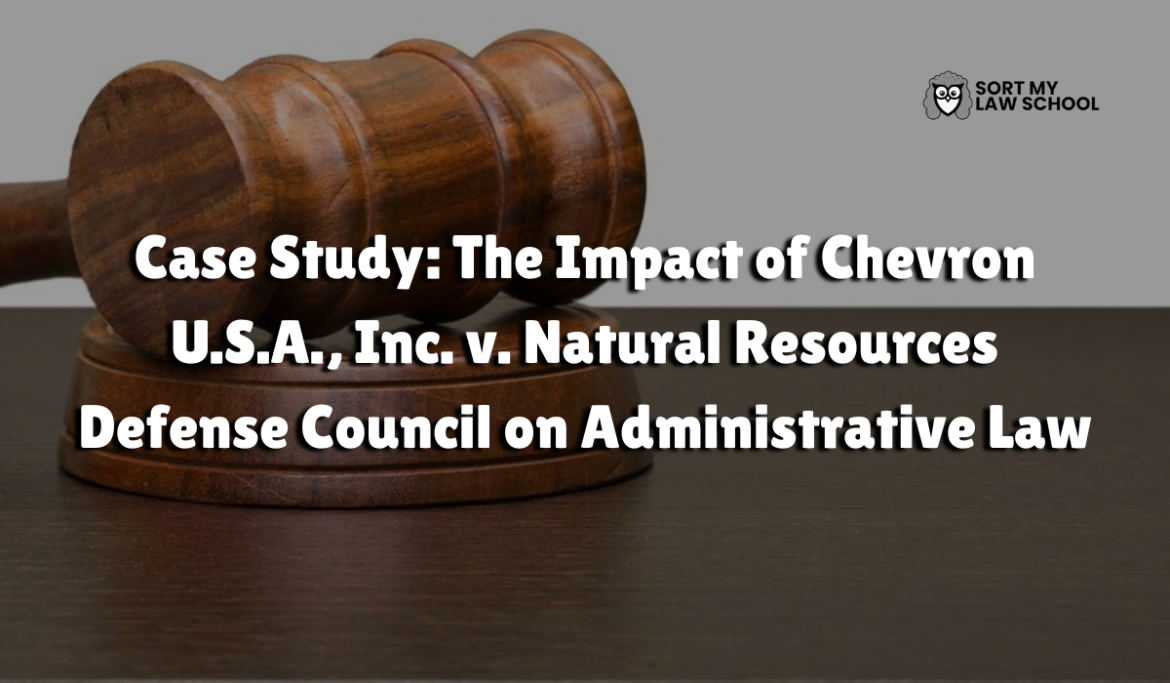Chevron U.S.A., Inc. v. Natural Resources Defense Council, Inc.: A Landmark Supreme Court Decision :
Chevron U.S.A., Inc. v. Natural Resources Defense Council, Inc., 467 U.S. 837 (1984), was a pivotal Supreme Court case that established the “Chevron deference,” a critical doctrine in U.S. administrative law. This doctrine determines when federal courts should defer to a government agency’s interpretation of a statute. The Chevron deference involves a two-step test: first, whether Congress has directly addressed the precise issue at hand, and second, whether the agency’s interpretation is a permissible construction of the statute.
Case Background
The case arose from a dispute over the interpretation of the term “source” in the Clean Air Act of 1963, a pivotal issue within Administrative Law. Initially, the Environmental Protection Agency (EPA) defined “source” broadly, encompassing almost any significant change or addition to a factory. However, in 1981, the EPA revised this definition to mean an entire plant, which allowed companies to avoid a lengthy review process if they offset new emissions by reducing emissions elsewhere in the plant. The Natural Resources Defense Council (NRDC) challenged this new definition, and the D.C. Circuit Court ruled in their favor, finding the EPA’s interpretation inconsistent with prior case law. Chevron Corporation, affected by the regulation, appealed to the Supreme Court.
Supreme Court Decision
On June 25, 1984, the Supreme Court unanimously ruled in favor of the EPA. Justice John Paul Stevens, writing for the Court, emphasized that when a statute is ambiguous, Congress implicitly delegates authority to the relevant agency to interpret it. The Court criticized the D.C. Circuit for attempting to set policy, underscoring that policy decisions should be made by political branches, not the judiciary. This decision introduced the Chevron two-step analysis for reviewing agency interpretations of statutes, a landmark development in Administrative Law.
Chevron Two-Step Analysis
-
Step One: Determine if Congress has directly spoken on the issue. If Congress’s intent is clear, both the court and the agency must follow that clear intent, a fundamental principle in Administrative Law.
-
Step Two: If the statute is ambiguous, the court must determine whether the agency’s interpretation is reasonable. If it is, the court defers to the agency, a key aspect of Administrative Law known as Chevron deference.
This framework has been highly influential in administrative law, cited in numerous cases since its inception.
Legal Context and Impact
Historical Background
The Chevron decision builds on principles established in earlier cases, such as Marbury v. Madison, which affirmed the judiciary’s authority to review legislative actions for constitutionality. The Constitution, however, does not specify limits on the delegation of authority to agencies; such limits are set by statutes enacted by Congress. The courts have historically granted deference to administrative interpretations that align with statutory purposes, as seen in precedents like Skidmore v. Swift & Co. and Red Lion Broadcasting Co. v. FCC, highlighting the significance of Administrative Law in shaping regulatory frameworks.
Case Specifics
The Clean Air Act amendments of 1977 required new projects causing significant pollution to undergo EPA review. Initially, the EPA’s broad definition of “source” included any significant factory modification. In 1981, under President Reagan, the EPA redefined “source” to mean an entire plant, simplifying compliance for companies making internal adjustments to offset new emissions. This change aimed to facilitate industrial development while maintaining overall pollution levels, reflecting a significant shift in Administrative Law interpretation and implementation.
The NRDC challenged this reinterpretation, arguing it conflicted with previous legal interpretations. The D.C. Circuit sided with the NRDC, but the Supreme Court reversed this decision, upholding the EPA’s discretion under the Chevron doctrine, a pivotal moment in the realm of Administrative Law jurisprudence.
Importance and Reassessment
Chevron is a cornerstone of administrative law, balancing the roles of federal agencies and the judiciary in interpreting statutes. Its principles of deference to agency expertise in ambiguous cases have shaped legal practice for decades.In May 2023, the Supreme Court granted certiorari in Loper Bright Enterprises v. Raimondo to reassess Chevron. A decision expected in 2024 may potentially reshape this foundational doctrine.
Conclusion
Chevron U.S.A., Inc. v. Natural Resources Defense Council, Inc. established a critical framework for judicial review of administrative actions, emphasizing deference to agency expertise in the face of statutory ambiguity. This landmark decision underscores the judiciary’s role in respecting legislative and executive boundaries, significantly influencing the landscape of U.S. administrative law. As the Supreme Court revisits Chevron in 2024, the principles established in this case will be scrutinized, possibly leading to significant legal developments.




